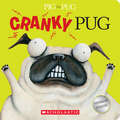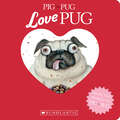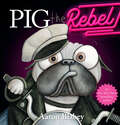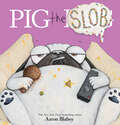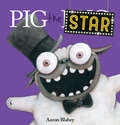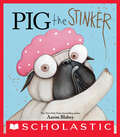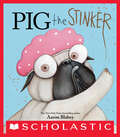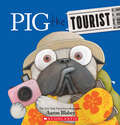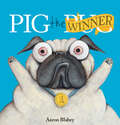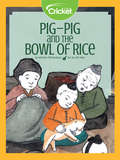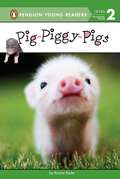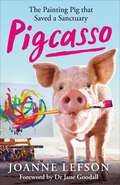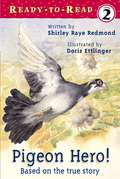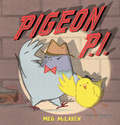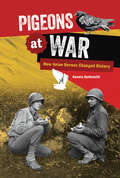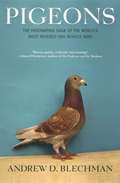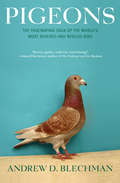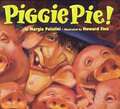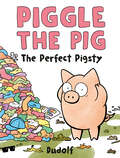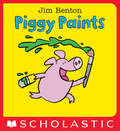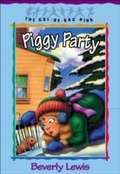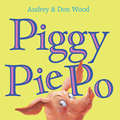- Table View
- List View
Pig the Pug: Cranky Pug (Pig the Pug)
by Aaron BlabeyPig the Pug is back in a silly, simple feelings-themed board book -- with mylar mirror!Perfect for sharing all year long, this board book introduces the littlest Pig the Pug fans to feelings and emotions. Is Pig cranky, happy, or sleepy? Plus, babies and toddlers will love the mylar mirror in the back.From the world of Pig the Pug by #1 New York Times bestselling author, Aaron Blabey.
Pig the Pug: Love Pug (Pig the Pug)
by Aaron BlabeyBabies and toddlers will giggle along with this simple board book as they are introduced to what Pig the Pug loves best, from dancing and dress up, to friends, of course!Featuring silly illustrations and favorite Pig quotes, this board book with die-cut cover makes a sweet Valentine’s Day gift for the youngest Pig the Pug fans.
Pig the Rebel (Pig the Pug)
by Aaron BlabeyThe laughter is nonstop as everyone's favorite greedy and selfish pug is sent to obedience school in this picture book from #1 New York Times bestselling author-illustrator Aaron Blabey.Pig was a pugand I'm sorry to say,after years of his anticsit was now time to pay.Pig's bad behavior has finally caught up with him -- it's time for OBEDIENCE SCHOOL! Can this terrible pug ever be tamed? Not if he can help it...Rich with author-illustrator Aaron Blabey's signature rhyming text and unforgettable illustrations, Pig the Rebel is a laugh-out-loud story that follows the nine previous books in the series (Pig the Pug, Pig the Winner, Pig the Elf, Pig the Star, Pig the Fibber, Pig the Stinker, Pig the Tourist, Pig the Slob, and Pig the Monster).
Pig the Slob (Pig the Pug)
by Aaron BlabeyAn all-new Pig the Pug picture book from internationally bestselling author-illustrator Aaron Blabey.Pug was a Pug,and I'm sorry to say,he was shockingly lazy.Such a shameful display...Pig, the world's greediest pug, is back -- and he won't get off the couch! Pig spends all day, every day lounging around, binging snacks and TV. Trevor tries to convince him to come out and play, but Pig won't budge! Until one day, something happens to get Pig up off the couch once and for all...Rich with author-illustrator Aaron Blabey's signature rhyming text and unforgettable illustrations, Pig the Slob is a laugh-out-loud story that follows the seven previous books in the series (Pig the Pug, Pig the Winner, Pig the Elf, Pig the Star, Pig the Fibber, Pig the Stinker, and Pig the Tourist).
Pig the Star (Pig the Pug)
by Aaron BlabeyA hysterical and cautionary tale about stealing the show from the award-winning and bestselling creator of the Pig the Pug series.The world's most self-centered pug wants to be the star of a fun photo shoot. He pushes his good friend, Trevor, out of the way and hogs all of the costumes. He is going to be the star! But when the photographer starts to favor Trevor, Pig must try everything to steal back the show!Rich with laugh-out-loud rhyming text and hysterical pug-eyed illustrations, Pig the Star is destined for stardom!
Pig the Stinker (Pig the Pug)
by Aaron BlabeyPig the Pug and his best friend Trevor are back for another hilarious adventure in the bestselling series!In this hilarious adventure, Pig the Pug STINKS! Pig likes to be smelly, so he rolls around in the garbage, laps up spoiled milk, tracks dirty paw prints all over the house, and even sticks his head in the toilet! But enough is enough! Pig's owner tries to get him to take a bath, but Pig refuses! Pig has a plan to stop up the tub, but when it backfires, will Pig get clean after all? Rich with author-illustrator Aaron Blabey's signature rhyming text and unforgettable illustrations, Pig the Stinker is a laugh-out-loud story that teachers Pig -- and readers -- an important (and hilarious) lesson, just like in the five previous books in the series (Pig the Pug, Pig the Winner, Pig the Elf, Pig the Star, and Pig the Fibber).
Pig the Stinker (Pig the Pug)
by Aaron BlabeyPig the Pug and his best friend Trevor are back for another hilarious adventure in the bestselling series!In this hilarious adventure, Pig the Pug STINKS! Pig likes to be smelly, so he rolls around in the garbage, laps up spoiled milk, tracks dirty paw prints all over the house, and even sticks his head in the toilet! But enough is enough! Pig's owner tries to get him to take a bath, but Pig refuses! Pig has a plan to stop up the tub, but when it backfires, will Pig get clean after all? Rich with author-illustrator Aaron Blabey's signature rhyming text and unforgettable illustrations, Pig the Stinker is a laugh-out-loud story that teaches Pig -- and readers -- an important (and hilarious) lesson, just like in the five previous books in the series (Pig the Pug, Pig the Winner, Pig the Elf, Pig the Star, and Pig the Fibber).
Pig the Tourist (Pig the Pug)
by Aaron BlabeyPig the Pug is causing havoc and hilarity as he travels around the world.Pig was a Pugand I'm sorry to say,when he went on vacationhe'd cause great dismay.Everywhere he goes around the globe, Pig the Pug offends the locals and causes destruction and devastation. However, in the end, Pig's rudeness comes back to bite him...Rich with author-illustrator Aaron Blabey's signature rhyming text and unforgettable illustrations, Pig the Tourist is a laugh-out-loud story that follows the six previous books in the series (Pig the Pug, Pig the Winner, Pig the Elf, Pig the Star, Pig the Fibber, and Pig the Stinker).
Pig the Winner (Pig the Pug)
by Aaron BlabeyThe world's greediest pug won't play fair, and he'll do just about anything to win!Will Pig ever learn? He's an absolute cheat and quite the sore loser as well. But when Pig challenges his foot-long playmate, Trevor, to a kibble-eating contest, he accidentally stuffs more than just food in his mouth. Lucky for Pig, Trevor knows what to do and saves the day!Young readers will love Blabey's irresistibly quirky illustrations that are paired with a relatable lesson about learning to play nice. For dog and pet lovers everywhere.
Pig-Pig and the Bowl of Rice
by Siana LaForestYung Soo loves his best friend, Pig-Pig. They do everything together! When Pig-Pig goes missing, Yung Soo comes upon an army that plans to destroy his village. Despite sharing this warning with his village in time for everyone to escape, he must still make a hard sacrifice in order to save his home.
Pig-Piggy-Pigs (Penguin Young Readers, Level 2)
by Bonnie BaderLearn about teacup pigs in this fact-and-photo-filled book that captures all the charm of these adorable animals! This new nonfiction reader will teach kids about the breed, how to train them, and how to take good care of these unique animals.
Pigcasso: The painting pig that saved a sanctuary
by Joanne LefsonWhen Joanne Lefson took on a piglet at her animal shelter, the young sow proceeded to eat everything in her stable but a paint brush. In a flash of inspiration, Joanne attempted to introduce the pig to the art of painting - and thus Pigcasso was born. Starting out with a humble canvas on the sanctuary wall, Pigcasso's paintings are now owned by the likes of George Clooney, she has a Swatch watch design partnership, a wine label, and has eclipsed the previous world record holder for animal art. She's been commissioned by Nissan and has had exhibitions in Cape Town, Munich and Amsterdam. More than that, Pigcasso's art funds the food and veterinary services for all the animals at the sanctuary.Pigcasso is the story of this unique pig and of the circumstances that brought her and Joanne together to take the art world by storm and form a unique and unbreakable bond.
Pigeon Hero! (Ready-to-Read #Level 2)
by Shirley Raye RedmondIn a town in Italy during World War II the people have surrendered without firing a shot. But American warplanes are due to arrive, and the radio's broken, so no one can tell them to call off the attack! G. I. Joe, a carrier pigeon, is the only one who can take the message to the Americans. Will he make it in time and save the town?
Pigeon P.I.
by Meg McLarenThis clever and engaging picture book is a delightful and witty first look at the "noir" detective genre for young readers. A pigeon private investigator emerges from retirement to track down a birdnapper with the help of his feathered friends. A cute chick reports the crime and makes herself useful enough to become a partner in the detective agency, which by the end of the book is back in business. Includes comical directions for doing detective work.
Pigeon Post
by Arthur Ransome"A pigeon a day keeps the natives away" Nancy Blackett The Swallows (John, Susan, Roger, and Titty Walker), Amazons (Nancy and Peggy Blackett), and D's (Dorothea and Dick Callum) are spending their summer holidays prospecting for gold in the Lake District. In order to keep Mrs. Blackett informed of their doings they have brought along three carrier pigeons--Homer, Sophocles, and Sappho. Swallows and Amazons series. Sequel to "Coot Club." For grades 4-7 and older readers.
Pigeons (Nature's Children)
by John JacksonDescribes the physical features, habits and habitat of pigeons and doves.
Pigeons at War: How Avian Heroes Changed History
by Connie GoldsmithFor more than five thousand years, people all over the world have worked with pigeons to send and receive important messages. These birds carried weather reports in ancient Egypt, letters between Mongolian warriors in the 1200s, news in nineteenth-century Europe, and more. Homing pigeons became especially important during World Wars I and II. From famous pigeons such as Cher Ami and GI Joe to lesser-known birds such as No. 48, these avian heroes were crucial to war communications. They carried messages between officers and soldiers when phone, radio, or telegraph lines were cut or officers needed to send top secret communications, transporting vital information across great distances. Homing pigeons, like human heroes, received awards and medals for their service. In fact, pigeons earned the most medals of any animal for their services during these conflicts. Discover how pigeons were domesticated and trained for use in military conflicts, learn about some of their most daring flights, and explore how pigeons and humans continue to work together.
Pigeons: The Fascinating Saga of the World's Most Revered and Reviled Bird
by Andrew D. BlechmanFrom the Book Jacket: They have been worshiped as fertility goddesses and revered as symbols of peace. Domesticated since the dawn of man, they have been crucial to wartime communications for every major historical superpower from ancient Egypt to the United States and are credited with saving thousands of lives. One delivered the results of the first Olympics in 119 B.C. and another brought the news of Napoleon's defeat at Waterloo more than 2,500 years later. Charles Darwin relied heavily upon them to help formulate and support his theory of evolution. Yet the pigeon is reviled today as a rat with wings. How did we come to misunderstand one of mankind's most steadfast companions? In Pigeons, Andrew D. Blechman travels across the United States and Europe in a quest to chronicle the bird's transformation from beloved friend to feathered outlaw. From Brooklyn's Main Event, the pigeon world's equivalent of the Kentucky Derby, to the eighty-third Grand National, with its thousands of bizarre and beautiful show pigeons, and from a pigeon shoot where people pay to gun down live birds, to the nation's oldest and biggest squab farm, Blechman takes the reader deep into the weird and wonderful world of pigeon fanaticism. He meets with pigeon fanciers and pigeon haters alike, includingthe Queen of England's Royal Loft Manager and members of the radical "pro-pigeon underground"; chases Mike Tyson, America's most famous pigeon lover; and for the first time tells the remarkable story behind this seemingly unremarkable bird. You'll never look at a pigeon the same way again. ! ANDREW D. BLECHMAN is an award- winning journalist who has worked for the Los Angeles Times and the Des Moines Register. His writing has appeared in numerous publications, including Smithsonian magazine and The New York Times. He currently divides his time between Berkshire County, Massachusetts, and Germany.
Pigeons: The Fascinating Saga of the World's Most Revered and Reviled Bird
by Andrew D. BlechmanPigeons have been worshipped as fertility goddesses and revered as symbols of peace. Domesticated since the dawn of man, they’ve been used as crucial communicators in war by every major historical superpower from ancient Egypt to the United States and are credited with saving thousands of lives. Charles Darwin relied heavily on pigeons to help formulate and support his theory of evolution. Yet today they are reviled as "rats with wings.” Author Andrew D. Blechman traveled across the United States and Europe to meet with pigeon fanciers and pigeon haters in a quest to find out how we came to misunderstand one of mankind’s most helpful and steadfast companions. Pigeons captures a Brooklyn man’s quest to win the Main Event (the pigeon world’s equivalent of the Kentucky Derby), as well as a convention dedicated to breeding the perfect bird. Blechman participates in a live pigeon shoot where entrants pay $150; he tracks down Mike Tyson, the nation’s most famous pigeon lover; he spends time with Queen Elizabeth’s Royal Pigeon Handler; and he sheds light on a radical "pro-pigeon underground’ in New York City. In Pigeons, Blechman tells for the first time the remarkable story behind this seemingly unremarkable bird.
Piggie Pie!
by Margie PalatiniGritch the witch flies to Old MacDonald's farm for some pigs to make a piggie pie, but when she arrives she can't find a single porker.
Piggle
by Crosby BonsallFrom the book: Piggle? What kind of game is that? Homer and Bear know. Lolly, Molly, Polly and Dolly know, and so do Rabbit and Duck. Even Pig thinks he knows. How do you piggle? Beginning readers will love finding out in Crosby Bonsall's satisfying story about a boy who is looking for someone to play with This spirited sequel to the popular Who's A Pest? [available from Bookshare] will thoroughly delight young children.
Piggle the Pig: The Perfect Pigsty
by DudolfIntroducing an irresistible new character, sure to capture the hearts (and giggles) of readers everywhere, perfect for fans of Don't Let the Pigeon Drive the Bus and the Pig the Pug series!This one-of-a-kind picture book is a guaranteed laugh for messy kids ages 0–99."Whole-hog fun."--Kirkus ReviewsWhen Piggle's parents let him know that they'll be stopping by, preparing for their visit seems positively easy. All he has to do is put away several months' worth of laundry, remove an extraordinary amount of trash, and wipe down any surfaces that might be covered in grime and mildew (which is all of them). And wait... who is that living in the washing machine? Nothing your average pig can't handle!Children who dread room-cleaning day, adults who freeze up when facing the task of housecleaning, or just about anyone who has faced down a sink full of dishes will find Piggle's struggle relatable. Uniquely hilarious, Piggle the Pig will delight readers as he faces the universal struggle of preparing for unanticipated houseguests.
Piggy Paints: A Big & Little Book
by Jim BentonJim Benton brings on the humor in a brand-new line of board books!Piggy paints big. Piggy paints little.Piggy paints pigs with a kitty in the middle.Piggy paints little. Piggy paints big.Piggy paints a pretty little polka-dot pig.Jim Benton, the international bestselling author and illustrator of Dear Dumb Diary, presents a clever, rollicking new board book program that will leave toddlers wide-eyed and laughing. Fans of Sandra Boynton will rejoice in this fresh line of funny stories!Each board book features: - Hilarious stories based on early concepts - Endearing characters- Young, bold, colorful artwork
Piggy Party (The Cul-de-Sac Kids #19)
by Beverly LewisBook 19 in The Cul-De-Sac Kids chapter book series for young readers. When Carly Hunter takes the class guinea pig home for the weekend and decides to test Piggy's skill for weather-telling on Groundhog Day, trouble can't be far away.
Piggy Pie Po
by Audrey Wood Don WoodWho is Piggy Pie Po? Just the smartest (maybe), messiest (probably), silliest (definitely) piggy you'll ever meet. In these three small and playful stories, he's sure to become every child's most unforgettable new friend. Award-winning team Audrey and Don Wood's picture books have been loved by children and parents for more than twenty-five years. With perfect pacing and exuberant illustrations, Piggy Pie Po introduces a new character that will be embraced by the next generation of little ones.
